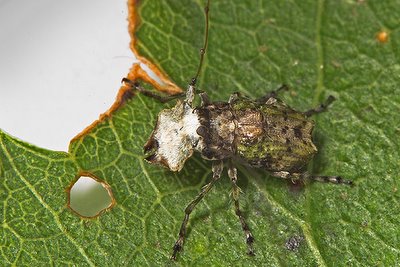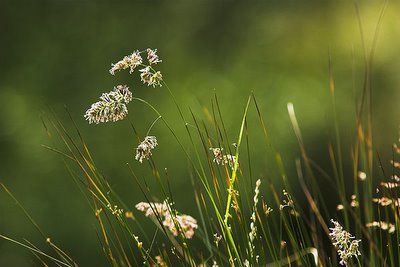 Small things tend to go unnoticed—it’s hardly surprising, and there must be innumerable reasons for it. However, I suspect one major reason is simply that paying attention to tiny things requires more effort. Sometimes, considerable effort. Take this little beetle as an example. He’s about the size of a match head, but not as fat, and with those colours and bumps he’d be pretty difficult to spot on the bark of a tree. In fact, you’d have to inspect a lot of bark, very closely, to find one of these, and all that inspecting would require a lot of effort and would necessarily be at the expense of other things—possibly more important things, like enjoying the sun on the verandah in the evening while eating a nice bit of cheese, or whatever else you might consider more important than searching for Hoherius meinertzhageni. Actually, it’d be much easier to find his name than him—it’s about 10–15 times longer than he is, and would stand out much better against the bark1.
Small things tend to go unnoticed—it’s hardly surprising, and there must be innumerable reasons for it. However, I suspect one major reason is simply that paying attention to tiny things requires more effort. Sometimes, considerable effort. Take this little beetle as an example. He’s about the size of a match head, but not as fat, and with those colours and bumps he’d be pretty difficult to spot on the bark of a tree. In fact, you’d have to inspect a lot of bark, very closely, to find one of these, and all that inspecting would require a lot of effort and would necessarily be at the expense of other things—possibly more important things, like enjoying the sun on the verandah in the evening while eating a nice bit of cheese, or whatever else you might consider more important than searching for Hoherius meinertzhageni. Actually, it’d be much easier to find his name than him—it’s about 10–15 times longer than he is, and would stand out much better against the bark1. Yes, that’s him—and yes, he is a male: you can tell because he has a big head. The females are much more normal. Don’t ask me why the males have those huge2, flattened, whitish heads; I could speculate indefinitely but testing all those hypotheses would interfere even more with eating cheese on the verandah (for example), and as far as I know, no one knows. In fact, the sum of knowledge about H. meinertzhageni is largely included in Bev Holloway’s monograph on the New Zealand Anthribidae3. It’s not a lot, but at least it tells you you’re likely to be wasting your time looking for H. meinertzhageni on anything but plants belonging to the mallow family4, which makes it all the more surprising that I found this individual on the curtain in my laundry. I suspect it arrived from one of the lacebarks (Hoheria sp.) growing nearby.
Now, I’m sure many people would have either ignored the small speck on the curtain or reached for the flyspray, but my years of entomological training prompted me to look closer. On realising I had a live, male H. meinertzhageni loose in my house, I decided to try for a photo, so I found the nearest handy container (which had contained leftover lasagne but was now, surprisingly, washed and spotless) and after a careful stalk, captured him. I was determined not to repeat the same, shameful mistake I’d made with the weta, so I set up the camera, attempted a few photos, then left him with a sprig of freshly clipped lacebark for an hour or two before experimenting with a few more photos. Having confined him for long enough, I took him outside and watched as he cleaned his antennae,  turned a couple of circles then took to the air. He disappeared from view within a few seconds, but when I last saw him he was heading for the bush on the edge of the terrace.
turned a couple of circles then took to the air. He disappeared from view within a few seconds, but when I last saw him he was heading for the bush on the edge of the terrace.
Many years ago I would probably have killed him, glued him to a triangle of card, and pinned the arrangement into a box with a label. The specimen (that’s what he would then have been called) might or might not have added an infinitesimal amount to our store of scientific knowledge. But it’s been years since I’ve felt like collecting insects, and seeing him fly off like that, I felt an enormous sense of delight. He may have been tiny, and the noticing and photographing may have required effort, but the reward has been immense. Good luck, little fella.
Now, where’s that nice bit of cheese...
1 Hoherius meinertzhageni was originally called Proscoporhinus albifrons—which would be even harder to spot against the bark, as it’s very slightly shorter (if the fount’s the same).
2 Relatively speaking. A millimetre wide isn’t usually considered enormous.
3 Holloway BA 1982. Anthribidae (Insecta: Coleptera). Fauna of New Zealand 3. Lincoln, NZ, Manaaki Whenua Press. 272 p. ISBN 0-477-06703-4.
4 "Hoherius meinertzhageni has been reared only from endemic Malvaceae" (Holloway 1982). However, I’ve found adults on the introduced (i.e. not native) mallow Lavatera trimestris. As far as I’m aware, this has not been recorded in the scientific literature, nor any other published literature, until now.
Photo 1: That's him.
Photo 2: Morning grass, Pohangina Valley.
Photos and words copyright 2005 Pete McGregor
5 comments:
A nice post Pete, and a great blog, excellent writing. BTW, NZ Mainland tasty cheese used to be my favourite, but lately I've been enjoying some very nice locally made Wensleydale!
After reading further I realize I should have said excellent photos too!
Cheers Duncan. You should be careful about letting on about the nice Wensleydale in case Wallace finds out and cleans up the local supply. Although, I do understand his current favourite is Stinking Bishop, so you might be ok.
Love that photo of yours of the jassids and sugar ants.
Hi Pete, your photos of Hoherius are fantastic! I'm an entomologist at the University of Auckland and am interested in this species - particularly the shield-like rostrum on the males. Would you mind sending me your email address so I could ask you a couple of questions? Mine is cpai015[at]aucklanduni.ac.nz. Regards, Chrissie Painting
Thanks Chrissie. I've emailed you, so if it's not in your inbox, check the spam folder ;^)
Post a Comment